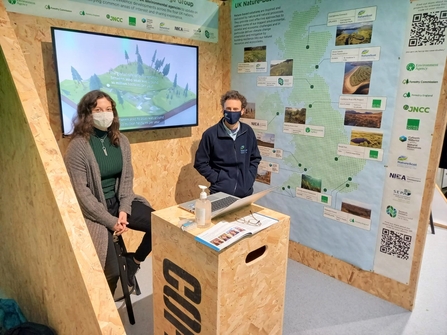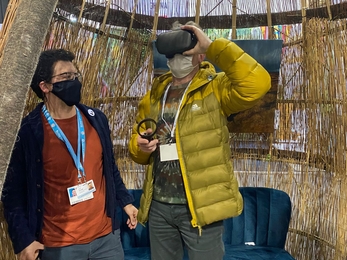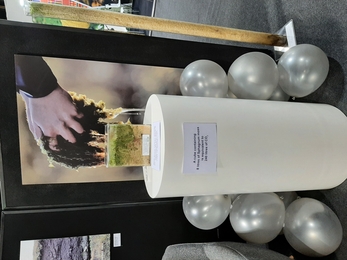Not many of us can have failed to notice COP26 being held last year in Glasgow! For the Great Fen it was a fantastic opportunity to bring our Water Works project to an international audience. Let’s take a look at how the Great Fen featured over the two weeks.
The Peatland Pavilion
The first-ever Peatland Pavilion was located within the main conference in the Scottish Events Campus (SEC) (referred to as the Blue Zone) and highlighted the importance of global peatlands for the climate, people, and the planet as a key nature-based solution to climate change.
All of the presentation sessions that took place in the physical Peatland Pavilion in the Blue Zone were live streamed and recorded for later playback and over 1700 delegates from 100 different countries entered the online conference platform to watch these.
The centrepiece of the pavilion was the Water Droplet installation, designed and built by Richard Lindsay and Jack Clough (University of East London) with the help of a dedicated build team, Julie Van Offelen and Sarah Proctor (IUCN UK Peatland Programme). Excitingly, the water droplet was constructed using wetland materials including willow and common reed, showcasing the potential of wetland products we're trialling in our paludiculture beds.
On site for the duration was Jack Clough, Research Assistant with the Sustainability Research Institute at the University of East London, and a key partner working with The Great Fen to record the impact of our projects on carbon emissions.
Jack said, “The Peatland Pavilion at COP26 was a fantastic opportunity to showcase the benefits of peatlands on the global stage. The goal was to raise awareness of the importance of peatlands in the climate and biodiversity crises and I mentioned the Water Works project and Eyes on the Bog to everyone I could. The reach was truly global and the physical pavilion really captured people’s imaginations and provided a popular, welcoming space to host Cabinet Secretaries, Ministers, civil servants, peatland experts, SEC staff and pavilion visitors.
“It was a real privilege to welcome all our attendees, media and party members and every visitor to the pavilion genuinely left with some new knowledge or ideas about peatlands. Particular exhibit highlights were the sphagnum moss display, showcasing the carbon sequestration potential of this amazing moss (also a crop at Water Works), and a virtual reality headset through which you could see the virtual pavilion in 3D, which Chris Packham was keen to try out!
This was the first ever pavilion devoted to peatlands at any Conference of Parties (CoP) for any environmental inter-governmental treaty, so this was a brilliant start. However, the pavilion is only as good as its content, so innovative projects like Water Works are essential for developing future content that demonstrate the massive potential for peatland conservation and the robust science underpinning them”.
A Virtual Peatland Pavilion was also created to complement the physical Peatland Pavilion as a long-lasting resource and knowledge hub. It hosted a fantastic range of video and multimedia content from global peatland organisations covering topics such as restoration, nature conservation, carbon and paludiculture. Created by Richard Lindsay, the Virtual Peatland Pavilion has a wealth of digitised content for you to enjoy and we encourage you all to explore and share this fantastic resource. The Great Fen features in Dome 4.
Great Fen video inside the virtual peatland pavilion
Great Fen Film
The Wildlife Trust BCN made an inspiring three-minute film for release at COP26 in the IUCN Peatland Pavilion which discusses Nature-based Solutions in the fight against climate change, particularly rewetting peat to prevent the loss of CO². The film featured the wider restored wetland landscape of the Great Fen and our current small scale wet farming Water Works which we will be scaling up as part of our Peatland Progress project. The film shows how the Great Fen demonstrates practical, achievable actions that can tackle climate change and bring hope. These are also key themes that will be developed in our Peatland Progress Project. A one-minute version was made for social media.
The film reached a global audience and potentially Heads of State and government-level policy makers at COP26 via the IUCN virtual Peatland Pavilion.
The Great Fen and wet farming – a natural solution to our changing climate
Launched at COP26 - Global IUCN Global Standard for Nature-based Solution
The Great Fen is honoured to be feeding into an emerging Global IUCN Global Standard for Nature-based Solutions (Nbs) which is a user-friendly framework for the verification, design and scaling up of NbS. This was launched at COP26 on 6th November. You can watch the launch event here, starting at 51:00 and featuring Project Manager Kate Carver at 2:13:24.
In July 2021 the Great Fen was selected as one of only 13 sites globally to act as an “Early Mover” to trial the methodology, and complete an assessment tool requiring evidence on how the Great Fen satisfied eight headline NbS criteria and underlying indicators. As a lasting legacy, the IUCN intends to cite the Great Fen as a case study in its global PANORAMA learning platform. PANORAMA promotes solutions that demonstrate how well-protected biodiversity and well-managed ecosystems help address societal challenges and thereby achieve development benefits.
As part of the launch at COP26, the IUCN also released a blog from Kate on the Great Fen experience as an Early Mover giving us even greater opportunity to reach an international audience at COP26.
The Green Zone
Running alongside the main conference and situated in the Glasgow Science Centre, the COP26 Green Zone was open to the public to discover what real action is being taken around the world by organisations, youth groups, civil society, academia, artists and business. It was filled with diverse exhibits, events, workshops and talks that promote dialogue, awareness, education and commitments to climate action.
On Tuesday 2nd November, the UK Inter-agency Climate Change Group exhibited in the Green Zone showcasing 12 Nature-based Solution projects from across the UK. Featuring on the map on their stand, they highlighted the restoration on the Great Fen as one of the solutions that can play a leading role in delivering a net zero future.
JNCC is hosting a visual of the map with further information on each of the projects on behalf of the Inter-Agency Climate Change Group at https://jncc.gov.uk/our-work/nature-based-solutions-iaccg-case-studies/.

The UK Inter-agency Climate Change Group stand in the green zone at COP26 - @nature_scot
Overall, we are thrilled with the response to the Water Works project, the interest in the potential for paludiculture crops and the increased awareness around the globe of the importance of protecting and restoring our peatlands. We are excited to see what the future holds in the fight against climate change and encouraged by the support shown both at COP26 and as we continue our important work in the Great Fen.
You can read more about the Wildlife Trusts’ takeaways from COP26, and the 10 areas of focus they’ve identified as being desperately needed here.









